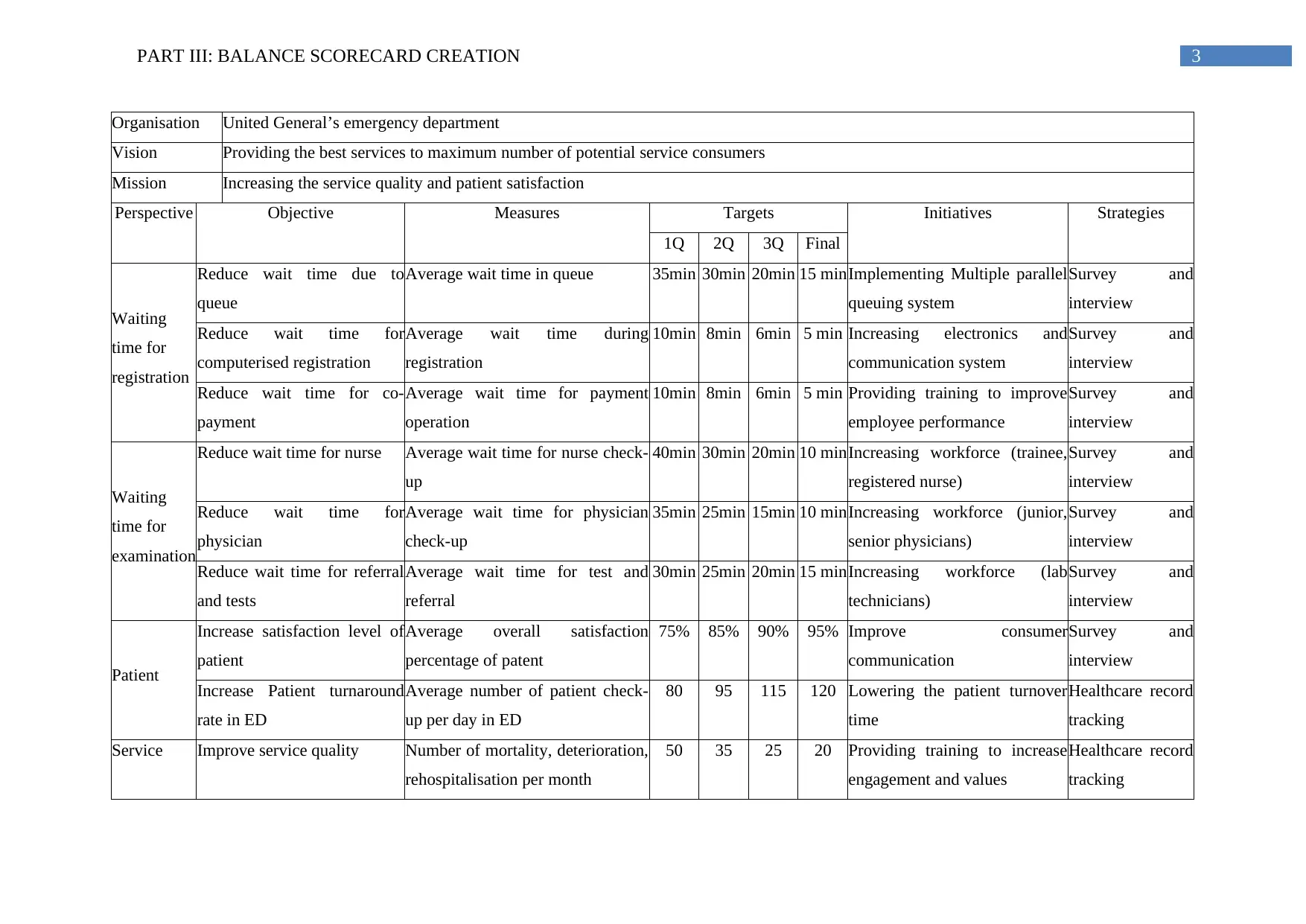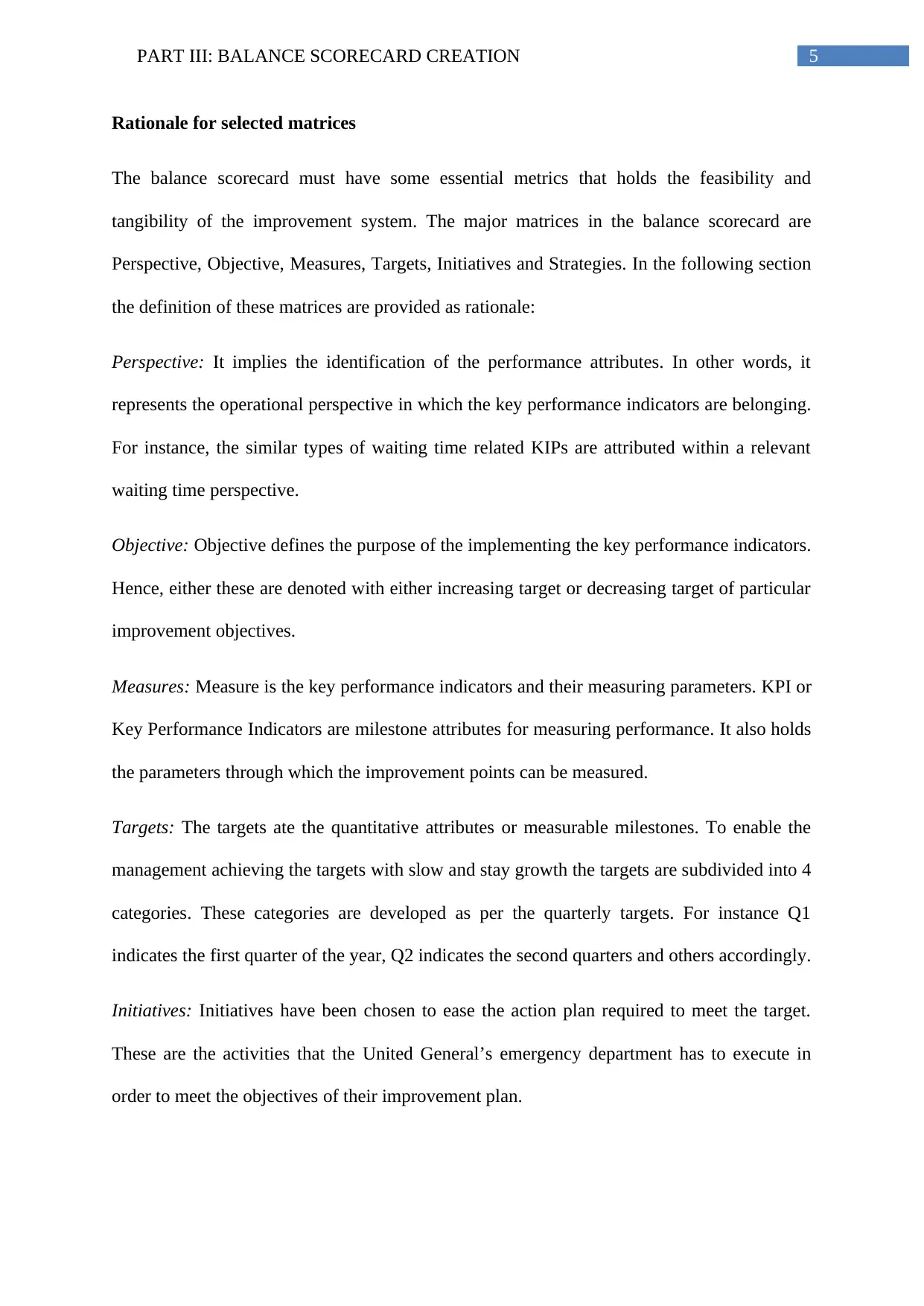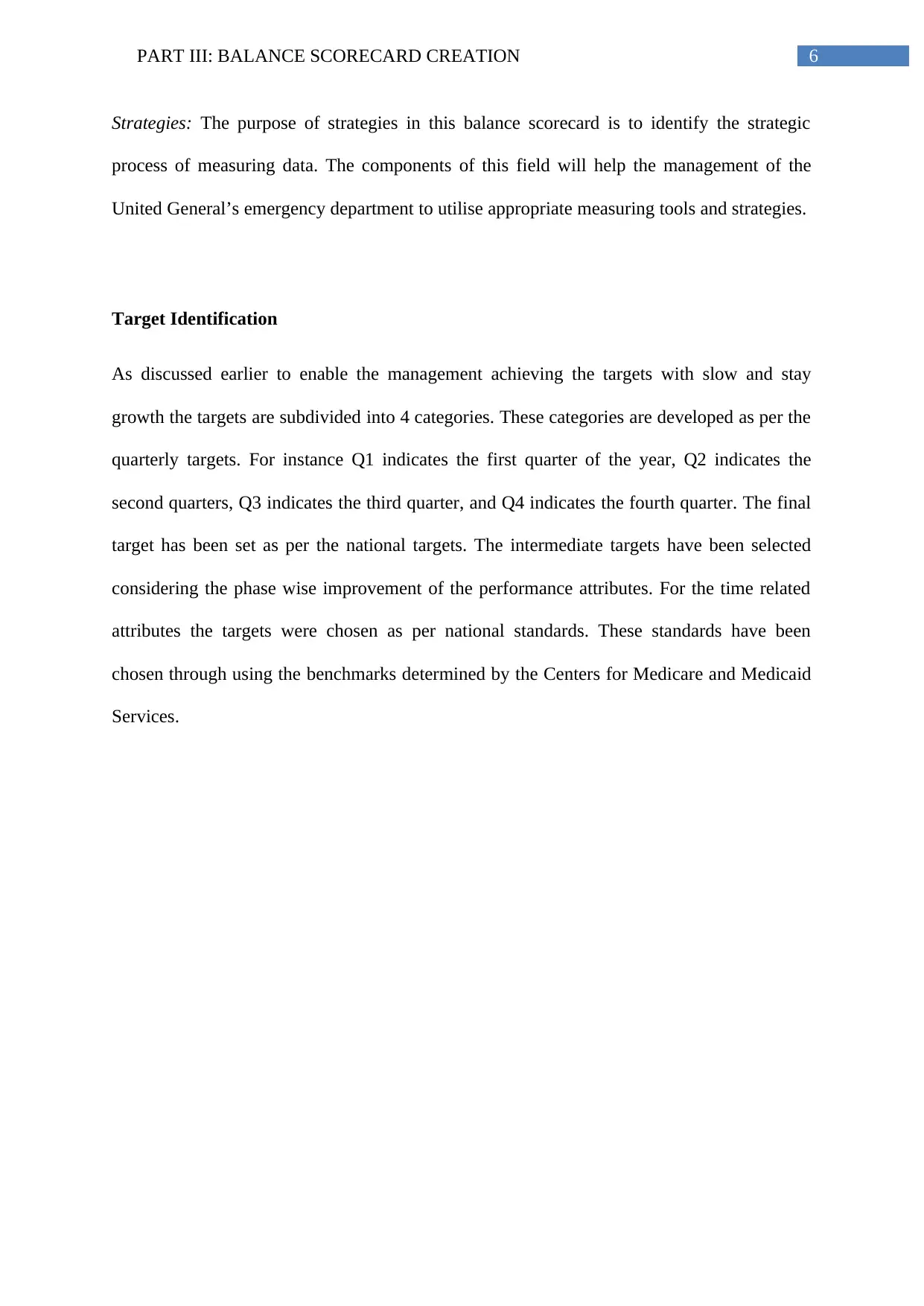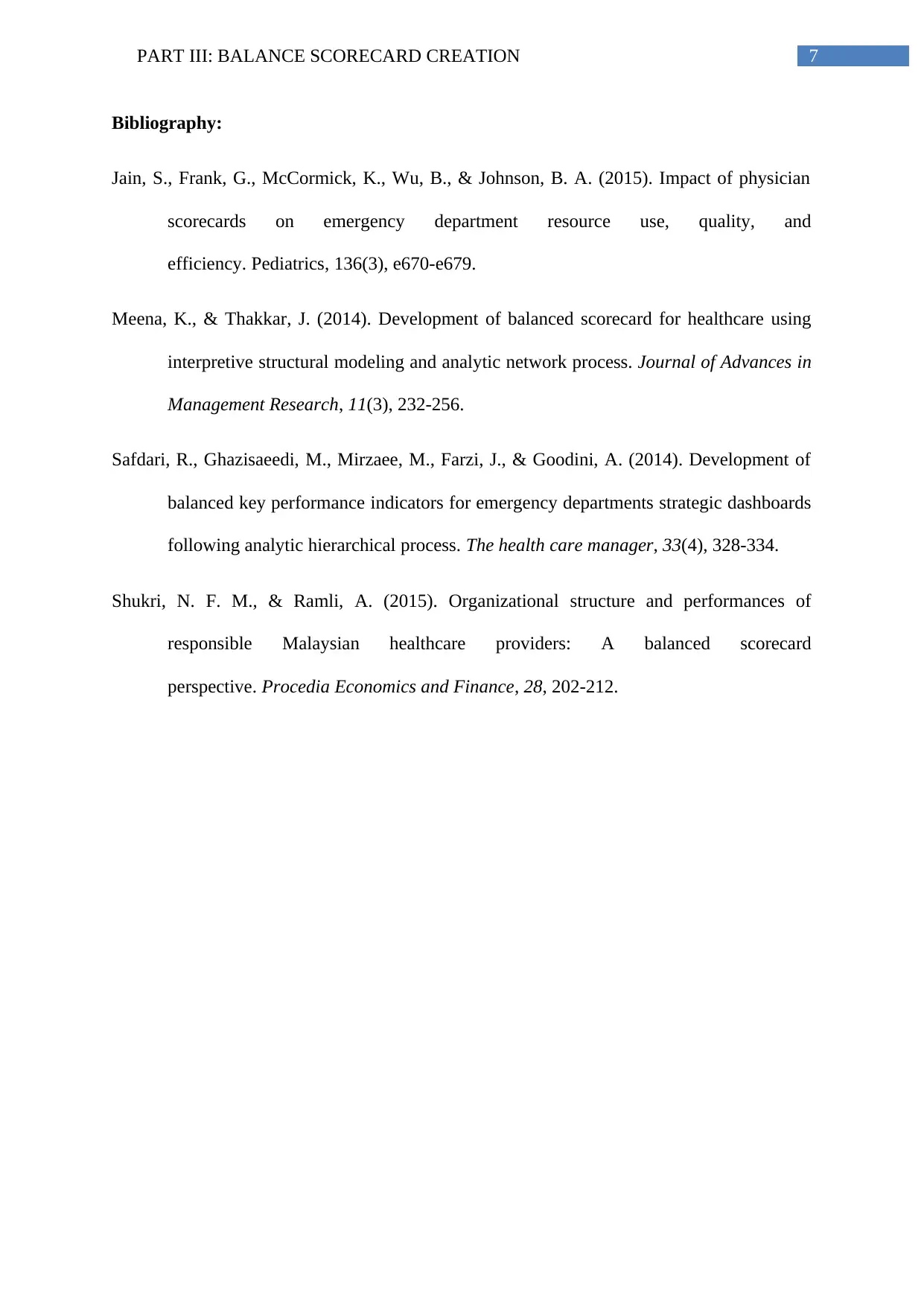Balance Scorecard Creation for United General's Emergency Department
VerifiedAdded on 2022/10/02
|7
|1057
|239
Report
AI Summary
This report details the creation of a balance scorecard for the emergency department of United General Hospital, aimed at improving performance, efficiency, and patient satisfaction. The report begins with an introduction to the balance scorecard as a strategic tool, followed by the presentation of a scorecard tailored for the CEO of the emergency department. The scorecard includes perspectives, objectives, measures, targets, initiatives, and strategies designed to address key areas such as waiting times, patient satisfaction, and service quality. The rationale behind the selection of each matrix is provided, explaining how each component contributes to the overall improvement plan. The report also outlines the target identification process, detailing how quarterly and final targets were established based on national benchmarks. The initiatives and strategies are designed to optimize resource allocation and streamline processes within the emergency department. The report concludes with a bibliography of relevant research used to inform the design of the balance scorecard.

Running head: PART III: BALANCE SCORECARD CREATION
Part III: Balance Scorecard Creation
Name of the Student
Name of the University
Author note
Part III: Balance Scorecard Creation
Name of the Student
Name of the University
Author note
Paraphrase This Document
Need a fresh take? Get an instant paraphrase of this document with our AI Paraphraser

2PART III: BALANCE SCORECARD CREATION
Introduction:
As discussed in part II, Balance Scorecard is a very effective strategy tool for any
organisation that can improve the performance, efficiency and productivity of the employees
and well as the organisational operations. The purpose of this report to develop a Balance
Scorecard for Chief Executive Officer of United General’s emergency department, so that
they could utilise this scorecard for holistic improvement of performance and quality of the
emergency department. In the following section, the balance scorecard has been presented
along with the rationale for selection of the matrices and the target identification process.
Introduction:
As discussed in part II, Balance Scorecard is a very effective strategy tool for any
organisation that can improve the performance, efficiency and productivity of the employees
and well as the organisational operations. The purpose of this report to develop a Balance
Scorecard for Chief Executive Officer of United General’s emergency department, so that
they could utilise this scorecard for holistic improvement of performance and quality of the
emergency department. In the following section, the balance scorecard has been presented
along with the rationale for selection of the matrices and the target identification process.

3PART III: BALANCE SCORECARD CREATION
Organisation United General’s emergency department
Vision Providing the best services to maximum number of potential service consumers
Mission Increasing the service quality and patient satisfaction
Perspective Objective Measures Targets Initiatives Strategies
1Q 2Q 3Q Final
Waiting
time for
registration
Reduce wait time due to
queue
Average wait time in queue 35min 30min 20min 15 minImplementing Multiple parallel
queuing system
Survey and
interview
Reduce wait time for
computerised registration
Average wait time during
registration
10min 8min 6min 5 min Increasing electronics and
communication system
Survey and
interview
Reduce wait time for co-
payment
Average wait time for payment
operation
10min 8min 6min 5 min Providing training to improve
employee performance
Survey and
interview
Waiting
time for
examination
Reduce wait time for nurse Average wait time for nurse check-
up
40min 30min 20min 10 minIncreasing workforce (trainee,
registered nurse)
Survey and
interview
Reduce wait time for
physician
Average wait time for physician
check-up
35min 25min 15min 10 minIncreasing workforce (junior,
senior physicians)
Survey and
interview
Reduce wait time for referral
and tests
Average wait time for test and
referral
30min 25min 20min 15 minIncreasing workforce (lab
technicians)
Survey and
interview
Patient
Increase satisfaction level of
patient
Average overall satisfaction
percentage of patent
75% 85% 90% 95% Improve consumer
communication
Survey and
interview
Increase Patient turnaround
rate in ED
Average number of patient check-
up per day in ED
80 95 115 120 Lowering the patient turnover
time
Healthcare record
tracking
Service Improve service quality Number of mortality, deterioration,
rehospitalisation per month
50 35 25 20 Providing training to increase
engagement and values
Healthcare record
tracking
Organisation United General’s emergency department
Vision Providing the best services to maximum number of potential service consumers
Mission Increasing the service quality and patient satisfaction
Perspective Objective Measures Targets Initiatives Strategies
1Q 2Q 3Q Final
Waiting
time for
registration
Reduce wait time due to
queue
Average wait time in queue 35min 30min 20min 15 minImplementing Multiple parallel
queuing system
Survey and
interview
Reduce wait time for
computerised registration
Average wait time during
registration
10min 8min 6min 5 min Increasing electronics and
communication system
Survey and
interview
Reduce wait time for co-
payment
Average wait time for payment
operation
10min 8min 6min 5 min Providing training to improve
employee performance
Survey and
interview
Waiting
time for
examination
Reduce wait time for nurse Average wait time for nurse check-
up
40min 30min 20min 10 minIncreasing workforce (trainee,
registered nurse)
Survey and
interview
Reduce wait time for
physician
Average wait time for physician
check-up
35min 25min 15min 10 minIncreasing workforce (junior,
senior physicians)
Survey and
interview
Reduce wait time for referral
and tests
Average wait time for test and
referral
30min 25min 20min 15 minIncreasing workforce (lab
technicians)
Survey and
interview
Patient
Increase satisfaction level of
patient
Average overall satisfaction
percentage of patent
75% 85% 90% 95% Improve consumer
communication
Survey and
interview
Increase Patient turnaround
rate in ED
Average number of patient check-
up per day in ED
80 95 115 120 Lowering the patient turnover
time
Healthcare record
tracking
Service Improve service quality Number of mortality, deterioration,
rehospitalisation per month
50 35 25 20 Providing training to increase
engagement and values
Healthcare record
tracking
⊘ This is a preview!⊘
Do you want full access?
Subscribe today to unlock all pages.

Trusted by 1+ million students worldwide

4PART III: BALANCE SCORECARD CREATION
Paraphrase This Document
Need a fresh take? Get an instant paraphrase of this document with our AI Paraphraser

5PART III: BALANCE SCORECARD CREATION
Rationale for selected matrices
The balance scorecard must have some essential metrics that holds the feasibility and
tangibility of the improvement system. The major matrices in the balance scorecard are
Perspective, Objective, Measures, Targets, Initiatives and Strategies. In the following section
the definition of these matrices are provided as rationale:
Perspective: It implies the identification of the performance attributes. In other words, it
represents the operational perspective in which the key performance indicators are belonging.
For instance, the similar types of waiting time related KIPs are attributed within a relevant
waiting time perspective.
Objective: Objective defines the purpose of the implementing the key performance indicators.
Hence, either these are denoted with either increasing target or decreasing target of particular
improvement objectives.
Measures: Measure is the key performance indicators and their measuring parameters. KPI or
Key Performance Indicators are milestone attributes for measuring performance. It also holds
the parameters through which the improvement points can be measured.
Targets: The targets ate the quantitative attributes or measurable milestones. To enable the
management achieving the targets with slow and stay growth the targets are subdivided into 4
categories. These categories are developed as per the quarterly targets. For instance Q1
indicates the first quarter of the year, Q2 indicates the second quarters and others accordingly.
Initiatives: Initiatives have been chosen to ease the action plan required to meet the target.
These are the activities that the United General’s emergency department has to execute in
order to meet the objectives of their improvement plan.
Rationale for selected matrices
The balance scorecard must have some essential metrics that holds the feasibility and
tangibility of the improvement system. The major matrices in the balance scorecard are
Perspective, Objective, Measures, Targets, Initiatives and Strategies. In the following section
the definition of these matrices are provided as rationale:
Perspective: It implies the identification of the performance attributes. In other words, it
represents the operational perspective in which the key performance indicators are belonging.
For instance, the similar types of waiting time related KIPs are attributed within a relevant
waiting time perspective.
Objective: Objective defines the purpose of the implementing the key performance indicators.
Hence, either these are denoted with either increasing target or decreasing target of particular
improvement objectives.
Measures: Measure is the key performance indicators and their measuring parameters. KPI or
Key Performance Indicators are milestone attributes for measuring performance. It also holds
the parameters through which the improvement points can be measured.
Targets: The targets ate the quantitative attributes or measurable milestones. To enable the
management achieving the targets with slow and stay growth the targets are subdivided into 4
categories. These categories are developed as per the quarterly targets. For instance Q1
indicates the first quarter of the year, Q2 indicates the second quarters and others accordingly.
Initiatives: Initiatives have been chosen to ease the action plan required to meet the target.
These are the activities that the United General’s emergency department has to execute in
order to meet the objectives of their improvement plan.

6PART III: BALANCE SCORECARD CREATION
Strategies: The purpose of strategies in this balance scorecard is to identify the strategic
process of measuring data. The components of this field will help the management of the
United General’s emergency department to utilise appropriate measuring tools and strategies.
Target Identification
As discussed earlier to enable the management achieving the targets with slow and stay
growth the targets are subdivided into 4 categories. These categories are developed as per the
quarterly targets. For instance Q1 indicates the first quarter of the year, Q2 indicates the
second quarters, Q3 indicates the third quarter, and Q4 indicates the fourth quarter. The final
target has been set as per the national targets. The intermediate targets have been selected
considering the phase wise improvement of the performance attributes. For the time related
attributes the targets were chosen as per national standards. These standards have been
chosen through using the benchmarks determined by the Centers for Medicare and Medicaid
Services.
Strategies: The purpose of strategies in this balance scorecard is to identify the strategic
process of measuring data. The components of this field will help the management of the
United General’s emergency department to utilise appropriate measuring tools and strategies.
Target Identification
As discussed earlier to enable the management achieving the targets with slow and stay
growth the targets are subdivided into 4 categories. These categories are developed as per the
quarterly targets. For instance Q1 indicates the first quarter of the year, Q2 indicates the
second quarters, Q3 indicates the third quarter, and Q4 indicates the fourth quarter. The final
target has been set as per the national targets. The intermediate targets have been selected
considering the phase wise improvement of the performance attributes. For the time related
attributes the targets were chosen as per national standards. These standards have been
chosen through using the benchmarks determined by the Centers for Medicare and Medicaid
Services.
⊘ This is a preview!⊘
Do you want full access?
Subscribe today to unlock all pages.

Trusted by 1+ million students worldwide

7PART III: BALANCE SCORECARD CREATION
Bibliography:
Jain, S., Frank, G., McCormick, K., Wu, B., & Johnson, B. A. (2015). Impact of physician
scorecards on emergency department resource use, quality, and
efficiency. Pediatrics, 136(3), e670-e679.
Meena, K., & Thakkar, J. (2014). Development of balanced scorecard for healthcare using
interpretive structural modeling and analytic network process. Journal of Advances in
Management Research, 11(3), 232-256.
Safdari, R., Ghazisaeedi, M., Mirzaee, M., Farzi, J., & Goodini, A. (2014). Development of
balanced key performance indicators for emergency departments strategic dashboards
following analytic hierarchical process. The health care manager, 33(4), 328-334.
Shukri, N. F. M., & Ramli, A. (2015). Organizational structure and performances of
responsible Malaysian healthcare providers: A balanced scorecard
perspective. Procedia Economics and Finance, 28, 202-212.
Bibliography:
Jain, S., Frank, G., McCormick, K., Wu, B., & Johnson, B. A. (2015). Impact of physician
scorecards on emergency department resource use, quality, and
efficiency. Pediatrics, 136(3), e670-e679.
Meena, K., & Thakkar, J. (2014). Development of balanced scorecard for healthcare using
interpretive structural modeling and analytic network process. Journal of Advances in
Management Research, 11(3), 232-256.
Safdari, R., Ghazisaeedi, M., Mirzaee, M., Farzi, J., & Goodini, A. (2014). Development of
balanced key performance indicators for emergency departments strategic dashboards
following analytic hierarchical process. The health care manager, 33(4), 328-334.
Shukri, N. F. M., & Ramli, A. (2015). Organizational structure and performances of
responsible Malaysian healthcare providers: A balanced scorecard
perspective. Procedia Economics and Finance, 28, 202-212.
1 out of 7
Your All-in-One AI-Powered Toolkit for Academic Success.
+13062052269
info@desklib.com
Available 24*7 on WhatsApp / Email
![[object Object]](/_next/static/media/star-bottom.7253800d.svg)
Unlock your academic potential
Copyright © 2020–2025 A2Z Services. All Rights Reserved. Developed and managed by ZUCOL.